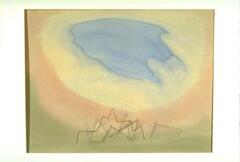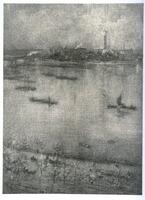4 Items in this Learning Collection
Collection Object
Collection Object
Collection Object
Collection Object
Copyright
All Rights Reserved
()
Blitzgefahr
Accession Number
1987/2.12
Title
Blitzgefahr
Artist(s)
Paul Klee
Artist Nationality
Swiss
Object Creation Date
1931
Medium & Support
watercolor on paper
Dimensions
18 in x 20 1/8 in (45.7 cm x 51.1 cm);22 3/16 in x 28 3/16 in (56.36 cm x 71.6 cm);18 1/8 in x 20 1/8 in (46.1 cm x 51.1 cm)
Credit Line
Gift of Henry Tracy Kneeland of Bloomfield, Connecticut, in memory of his parents, Frank G. Kneeland and Helen Dodge Kneeland
Label copy
This complex work was executed at the moment when Klee was dissolving his long association with the Bauhaus—a time of personal and professional stress. While an overall general sense of conflict pervades the work, Michigan scholar Jonathan Perkins has suggested a number of more specific references in the composition.From Klee's writings we learn that lightning was closely associated in the artist's mind with the traumatic death of Klee's close friend Franz Marc in 1916. (The death struck him "like a thunderbolt".) Klee also associated the jagged lightning strokes with the graph lines on the fever chart maintained during his son Felix's serious illness in 1909. Lightning also probably carried political meaning for Klee, being associated with the rise of Nazism, the concept of the Blitzkrieg, and the lightning bolt insignia of the SS.Above all, lightning seems to have been associated in Klee's mind where the process of nature were directly linked to artistic inspiration and creation.
Subject matter
For Klee, the concept of lightning, displayed in this work, represents several sets of contrasts in both art and nature. Formally, the soft, rounded, and lightly colored washes of color that make up the background here are sharply interrupted by the harsher, zigzagging lines along the bottom of the composition which represent the lightening. Klee kept many diaries and produced much writing on his theories of art and nature. For him, lightning represented both creation and destruction. He compared both positive and negative life events, such as the possibility of producing children and the death of a close friend, to striking bolts of lightning.
Physical Description
This watercolor consists of concentric areas of color. At the top is a blue cloud-like shape surrounded by a yellow ring in turn surrounded by an orange-pink color. The bottom edge is an olive-green color where we see thin zigzagging lines in red-brown.
Primary Object Classification
Painting
Collection Area
Modern and Contemporary
Rights
If you are interested in using an image for a publication, please visit http://umma.umich.edu/request-image for more information and to fill out the online Image Rights and Reproductions Request Form.
Keywords
Expressionism
Nature
creation (doctrinal concept)
destruction (process)
lightning
modern and contemporary art
zigzags
1987/2.12
Title
Blitzgefahr
Artist(s)
Paul Klee
Artist Nationality
Swiss
Object Creation Date
1931
Medium & Support
watercolor on paper
Dimensions
18 in x 20 1/8 in (45.7 cm x 51.1 cm);22 3/16 in x 28 3/16 in (56.36 cm x 71.6 cm);18 1/8 in x 20 1/8 in (46.1 cm x 51.1 cm)
Credit Line
Gift of Henry Tracy Kneeland of Bloomfield, Connecticut, in memory of his parents, Frank G. Kneeland and Helen Dodge Kneeland
Label copy
This complex work was executed at the moment when Klee was dissolving his long association with the Bauhaus—a time of personal and professional stress. While an overall general sense of conflict pervades the work, Michigan scholar Jonathan Perkins has suggested a number of more specific references in the composition.From Klee's writings we learn that lightning was closely associated in the artist's mind with the traumatic death of Klee's close friend Franz Marc in 1916. (The death struck him "like a thunderbolt".) Klee also associated the jagged lightning strokes with the graph lines on the fever chart maintained during his son Felix's serious illness in 1909. Lightning also probably carried political meaning for Klee, being associated with the rise of Nazism, the concept of the Blitzkrieg, and the lightning bolt insignia of the SS.Above all, lightning seems to have been associated in Klee's mind where the process of nature were directly linked to artistic inspiration and creation.
Subject matter
For Klee, the concept of lightning, displayed in this work, represents several sets of contrasts in both art and nature. Formally, the soft, rounded, and lightly colored washes of color that make up the background here are sharply interrupted by the harsher, zigzagging lines along the bottom of the composition which represent the lightening. Klee kept many diaries and produced much writing on his theories of art and nature. For him, lightning represented both creation and destruction. He compared both positive and negative life events, such as the possibility of producing children and the death of a close friend, to striking bolts of lightning.
Physical Description
This watercolor consists of concentric areas of color. At the top is a blue cloud-like shape surrounded by a yellow ring in turn surrounded by an orange-pink color. The bottom edge is an olive-green color where we see thin zigzagging lines in red-brown.
Primary Object Classification
Painting
Collection Area
Modern and Contemporary
Rights
If you are interested in using an image for a publication, please visit http://umma.umich.edu/request-image for more information and to fill out the online Image Rights and Reproductions Request Form.
Keywords
Expressionism
Nature
creation (doctrinal concept)
destruction (process)
lightning
modern and contemporary art
zigzags




